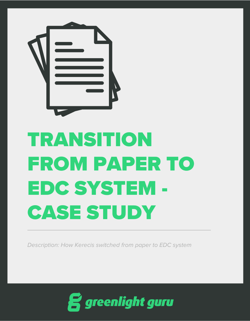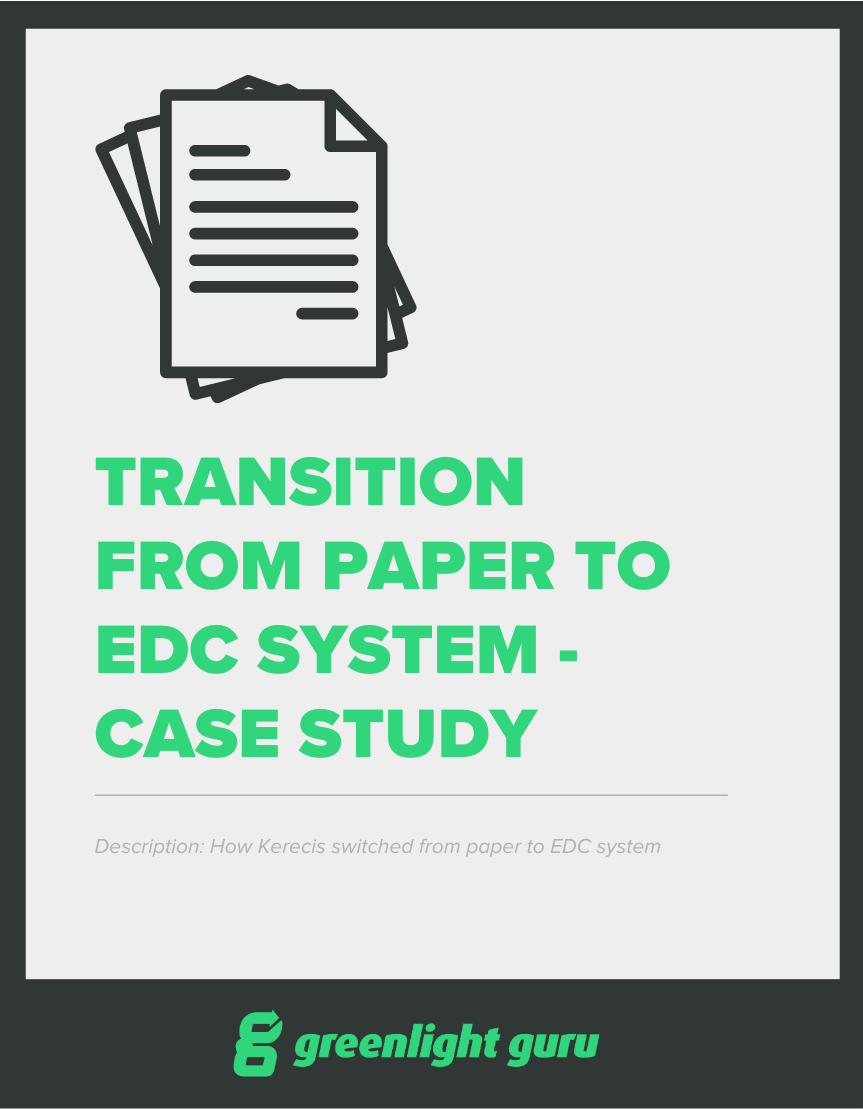Electronic Data Capture Systems vs. Paper-based Data Collection

In this blog, we’ll be comparing electronic data capture (EDC) systems to paper-based data collection systems. To do so, we’ll be reviewing four independent studies:
In each of these studies, the researchers frame clinical trials as a business expense. Doing so provides an objective lens through which to evaluate both electronic data capture and paper systems—specifically by comparing their respective impact on the clinical study’s cost, efficiency, and accuracy of data.
Electronic Data Capture lowers clinical data collection costs
Budgeting for clinical trials can be challenging for MedTech companies. That’s because unexpected costs can come from so many areas. In addition to the general high price of medical device development, clinical costs can be caused by:
-
Starting up and managing individual investigative sites
-
Travel to and from sites
-
Data management and security
-
Training of personnel and participants
-
Reimbursements or compensation
-
Third-party data analysis
Perhaps it really is, as they say, all about the money.
Thankfully, collecting data with an EDC system reduces the overall cost of conducting clinical trials. By streamlining the data collection process, leveraging automation to ensure high-quality data, and reducing the need for data cleaning and preparation, EDC systems reduce the total cost of data collection and analysis needed to complete a study.
We see evidence of this impact throughout the studies. One study found that using an EDC system decreased data collection costs by 55%, largely thanks to the use of e-Monitoring and remote data entry. Free from a need for physical investigation sites, clinical trial sponsors were able to reduce spending on site maintenance, travel, and onsite training.
The study also showed that the creation of electronic case report forms (eCRFs) led to an elimination of printing, binding, storage, and shipping costs. Another study echoed these findings, and added in its own fresh insight—utilizing eCRFs means faster database processing and shorter study periods.
With EDC systems, the ability to execute clinical studies more quickly means that medical device companies can fast-track their pathway to market authorization and start realizing profits even sooner than expected.
Electronic Data Capture makes clinical data collection more efficient
Time is a significant factor in the development and approval of medical devices, and any unnecessary delays during clinical data collection could disrupt release timelines for a MedTech company. With traditional paper-based data collection, physical CRFs must be completed by researchers, shipped to the study sponsor, and transferred by data entry teams into a computer database before analysis can occur.
Using an EDC software for clinical data collection bypasses this lengthy process by empowering researchers to create the data in a digital format with an electronic case report form (eCRF).
Rather than paper CRFs, collecting clinical data in a digital format with an eCRF means that the data can be securely uploaded to the cloud and shared with other stakeholders in near-real time.
Furthermore, a well-developed EDC system will allow for more accurate and easier data entry. The clinical researchers will then be able to review aggregate data and spot potential trends, which can be found and resolved more quickly.
In one study, researchers found that implementing an electronic data capture system over a paper-based system, led to efficiency improvements in three notable areas:
-
Clinical trial duration was down 30%
-
Time to locked database was down 43%
-
Number of queries was down 86%
Keeping a low number of queries is good, because an efficient query process means sites, Clinical Research Associates (CRAs) and data managers can quickly create and answer queries, keeping the data clean as the study progresses. An easy to review eCRF means investigators can review and sign final eCRFs efficiently, making the most of their valuable time.
A second study attributed increased efficiency to the use of mobile eCRFs, particularly for patient self-reported data. The study stated that there were “substantial time reductions.” The study goes on to state,
“This effect is not influenced by patient age, CRF item quantity or questionnaire variants."
This finding is significant, as it indicates well-designed eCRFs can drastically improve clinical data collection, regardless of whether it’s recorded by a CRA, a care provider, or self-reported by patients.
EDC improves data integrity and validity
In clinical trials, accuracy is essential for ensuring patient safety and obtaining regulatory approval, as well as ensuring the validity of the clinical data being collected. That’s because EDC systems offer improved accuracy compared to paper-based data collection methods.
The studies provide clear evidence of how electronic data capture drastically reduces the number of inaccurate data entries and lost or damaged paper CRFs.
One study found this was caused by the elimination of double data entry, noting that it provided time and cost savings. That same study also highlighted the reduction of necessary edit checks to eliminate errors.
Similarly, in Fleishman’s study of mobile CRFs, the researchers write a glowing recommendation, stating,
“Data integrity was superior in the eCRF condition. The use of eCRFs should be preferred over pCRFs in clinical research settings in terms of time efficiency, data quality and patient utilization.”
Introducing— MedTech's Leading EDC Solution
Greenlight Guru Clinical is the leading electronic data capture software and clinical data collection toolbox, purposefully built for MedTech. Collect and manage clinical data in pre and post-market clinical studies, including registries, cohorts, surveys, human factor testing, design validation, and more. Greenlight Guru Clinical meets the regulatory requirements of the FDA, EU, and most other countries, and ensures compliance out-of-the-box with GCP and ISO 14155:2020.
If you’re ready to start reaping the benefits of an electronic data capture system, contact us today for your free demo!
Jón Ingi Bergsteinsson, M.Sc. in Biomedical Engineering, is the co-founder of Greenlight Guru Clinical (formerly SMART-TRIAL). He was also the technical founder of Greenlight Guru Clinical where he paved the way for the platform’s quality standards, data security, and compliance.
Read More Posts
QMSR Mythbusters Episode
The “just enough” QMS: what does your pre-market team really need?
Did Christmas come early to the EU? Proposal to simplify EUMDR
Get your free resource
How Kerecis switched from paper to EDC system - a case study.











